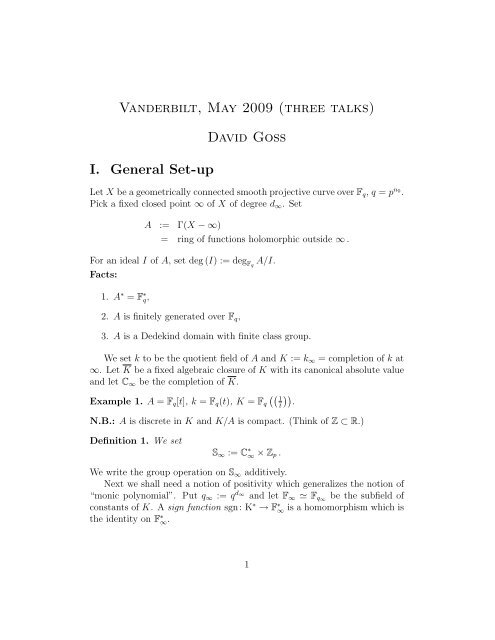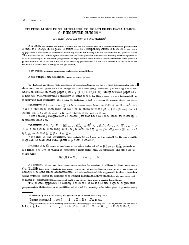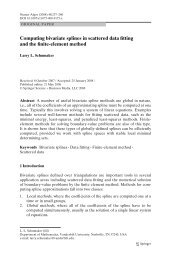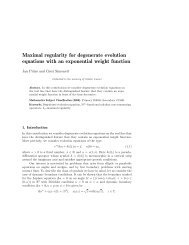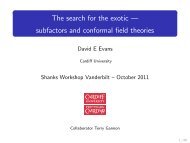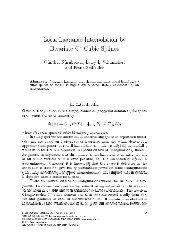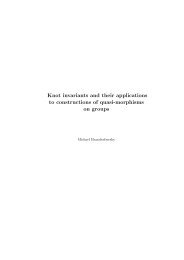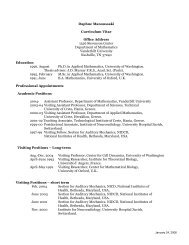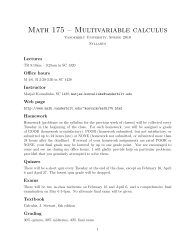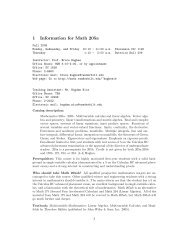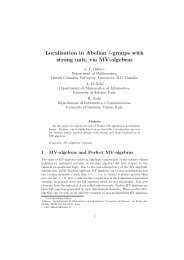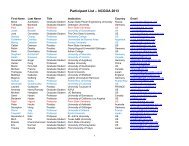Lecture Notes of David Goss
Lecture Notes of David Goss
Lecture Notes of David Goss
Create successful ePaper yourself
Turn your PDF publications into a flip-book with our unique Google optimized e-Paper software.
Vanderbilt, May 2009 (three talks)I. General Set-up<strong>David</strong> <strong>Goss</strong>Let X be a geometrically connected smooth projective curve over F q , q = p n 0.Pick a fixed closed point ∞ <strong>of</strong> X <strong>of</strong> degree d ∞ . SetA := Γ(X − ∞)= ring <strong>of</strong> functions holomorphic outside ∞ .For an ideal I <strong>of</strong> A, set deg (I) := deg FqA/I.Facts:1. A ∗ = F ∗ q,2. A is finitely generated over F q ,3. A is a Dedekind domain with finite class group.We set k to be the quotient field <strong>of</strong> A and K := k ∞ = completion <strong>of</strong> k at∞. Let K be a fixed algebraic closure <strong>of</strong> K with its canonical absolute valueand let C ∞ be the completion <strong>of</strong> K.Example 1. A = F q [t], k = F q (t), K = F q(( 1t)).N.B.: A is discrete in K and K/A is compact. (Think <strong>of</strong> Z ⊂ R.)Definition 1. We setS ∞ := C ∗ ∞ × Z p .We write the group operation on S ∞ additively.Next we shall need a notion <strong>of</strong> positivity which generalizes the notion <strong>of</strong>“monic polynomial”. Put q ∞ := q d∞ and let F ∞ ≃ F q∞ be the subfield <strong>of</strong>constants <strong>of</strong> K. A sign function sgn: K ∗ → F ∗ ∞ is a homomorphism which isthe identity on F ∗ ∞.1
Construction: Let π be an element <strong>of</strong> K with v ∞ (π) = 1, where v ∞ is thecanonical additive valuation at ∞ (i.e., π is a uniformizer). Let x ∈ K ∗ .Havex = ζ x π a 〈x〉where a ∈ Z, ζ x ∈ F ∗ ∞ and 〈x〉 ≡ 1 (π). Setsgn(x) := ζ x .Definition 2. We say x is positive if and only if sgn(x) = 1.The positive elements form a subgroup <strong>of</strong> K ∗ ; if x is positive and v ∞ (y) >v ∞ (x), then x + y is positive.Example 2. A = F q [t], π = 1 tgives the usual notion <strong>of</strong> “monic polynomial”.Let u = 1 + w where v ∞ (w) > 0. Let y ∈ Z p . Then u y = (1 + w) y =∞∑ )w j converges in K with the usual properties.j=0( yjMotivating Example: Put A = F q [t]; π = 1 t . Let s = (x, y) ∈ S ∞. We seta s := x −v∞(a) 〈a〉 y= x deg a (a/t deg a ) y .In particular, put s i := (t i , i) = (π −i , i), i ∈ Z. Soa s i= t i deg a (a/t deg a ) i = a i ,in the usual sense <strong>of</strong> a i .Note that the integral powers lie discretely in S ∞ .For general A we have ideals which are not principal or positively generatedif they are principal; thus have need to “exponentiate” general ideals.For x ∈ K set deg x := −d ∞ v ∞ (x). Let I be the ideal group <strong>of</strong> A. LetP ⊆ I be the subgroup <strong>of</strong> principal ideals and P + be subgroup <strong>of</strong> principaland positively generated ideals. We know I/P + is a finite abelian group.Lemma 1. Let Û1 ⊂ C ∗ ∞ be the group <strong>of</strong> 1-units (i.e., u = 1 + w wherev ∞ (w) > 0 for w ∈ C ∞ and v ∞ the canonical extension). Then Û1 is aQ p -vector space.Pro<strong>of</strong>. Û 1 is a Z p -module via the binomial theorem. But one can take uniquep j -th roots in characteristic p.2
Have a homomorphism 〈unique positive generator.〉: P + → Û1 given by 〈(a)〉 = 〈a〉 for a theCorollary 1. 〈 〉 extends uniquely to a homomorphism I → Û1.Pro<strong>of</strong>. Û 1 is divisible (and so injective) and I/P + is finite.Definition 3. Let I be an A-ideal and let s = (x, y) ∈ S ∞ . We setI s := x deg I 〈I〉 y .Let π ∗ be a fixed root <strong>of</strong> u d∞ − π = 0.Definition 4. We set s i := (π∗−i , i).Properties:1. (IJ) s = I s J s2. Let s, z ∈ S ∞ . ThenI s I z = I s+z .3. Let a ∈ A be positive and i ∈ Z. Then(a) s i= a i .Let I be an ideal. Suppose I t = (i) for i ∈ A positive and t > 0 a positiveinteger (in the usual sense). Set z := I (1) := I s 1.Lemma 2. z t = i.Pro<strong>of</strong>. We havez t = (I s 1) t (i.e., the element I s 1raised to t-th power)= I st= (I t ) s 1(i.e., the ideal I t raised to s 1 -power)= (i) s 1(i.e., the principal ideal (i) to the s 1 -power)= i .Definition 5. We set V := k({I s 1}) when I runs over all ideals <strong>of</strong> A.3
As I/P + is finite, we have [V : k] < ∞.Let O ⊂ V be the A-integers.Proposition 1. Every ideal <strong>of</strong> A becomes principal in O.Pro<strong>of</strong>. Suppose I t = (i) as above, and let z = I s 1. We have (O · I) t = O · iandz t = i .Comparing orders gives O · z = O · I.4
II. L-seriesMain Idea: Define L-series by Euler products in usual fashion. We willwork with Drinfeld modules and give here a short introduction to them.Let L be a field lying over Spec(A); i.e., there is a map ı: A → L. (Thekernel is called the “characteristic” <strong>of</strong> L.) Let τ be the endomorphism x ↦→ x q<strong>of</strong> G a /L. Let L{τ} be the noncommutative algebra <strong>of</strong> “polynomials” in τ.Definition 6. A Drinfeld module is a homomorphism ϕ: A → L{τ} suchthat1. For a ∈ A, ϕ a (τ) = ı(a)τ 0 + {higher terms}.2. For some a ∈ A, ϕ a (τ) ≠ ı(a)τ 0 .Part 2 is a nontriviality assumption.Let f(τ) =t ∑j=0a j τ j , a t ≠ 0, be in L{τ}. We set deg τ f := t. If ϕ is aDrinfeld module, as above, then for a ∈ A we setv ϕ (a) := − deg τ ϕ a (τ) .The following result then follows easily.Lemma 3.1. v ϕ (ab) = v ϕ (a) + v ϕ (b).2. v ϕ (a + b) ≥ min{v ϕ (a), v ϕ (b)}.Corollary 2. There is a rational number r ϕ such thatv ϕ (a) = r ϕ d ∞ v ∞ (a) = −r ϕ deg a .A simple counting argument shows that r ϕ is a positive integer called therank <strong>of</strong> the Drinfeld module.Let v be a prime <strong>of</strong> A not divisible by kernel ı. Let L be an algebraicclosure <strong>of</strong> L.Definition 7. We set ϕ[v j ] := {α ∈ L | ϕ a (α) = 0 for all a ∈ v j }.(This is the set <strong>of</strong> v j -division points.) Note that ϕ[v j ] becomes an A-module via ϕ. Counting also gives the next result.5
Lemma 4. ϕ[v j ] ≃ (A/v j ) rϕ as A-modules.Dualizing, we have the Tate module T v (ϕ) which is isomorphic to A rϕv asA v -module.Suppose now that L is a finite field; say L ≃ F q d. Let F := τ d . ClearlyF commutes with ϕ a (τ) for any a ∈ A (coefficients <strong>of</strong> ϕ a (τ) are fixed by F ).Thus F gives rise to an endomorphism <strong>of</strong> T v (ϕ).Theorem 1. The characteristic polynomial <strong>of</strong> F on T v (ϕ) has A-coefficientsindependent <strong>of</strong> v. Let α ∈ K be a root <strong>of</strong> P (x). Then|α| = (q d ) 1/rϕ .There are special rank 1 Drinfeld modules called “Hayes-modules”; theyplay the role in the theory classically played by the algebraic group G m . TheHayes-modules are defined over an extension H + <strong>of</strong> k which is Galois withgroup I/P + in line with class field theory.Let B be a prime <strong>of</strong> the A-integers <strong>of</strong> H + . By class field theory, the norm<strong>of</strong> B to A is principal and positively generated. We let nB be the uniquepositive generator <strong>of</strong> this ideal.Let L/H + be any finite extension <strong>of</strong> H + . Let I be an A-ideal and letL(I) be the extension adjoining I-division points <strong>of</strong> a Hayes module (definedabove for I = v j ). We know that L(I)/L is abelian with group isomorphicto a subgroup <strong>of</strong> A/I ∗ via the action <strong>of</strong> the Galois group and A on the I-division points. Let B now be a prime <strong>of</strong> L lying above Spec(A) − V (I); letσ B ∈ Gal(L(I)/L) be the Frobenius morphism. Then we haveσ B ↔ nB + I .Example 3. A = F q [t], L = k = F q (t). Then ϕ is determined byϕ t (τ) = tτ 0 +d∑a i τ i , a d ≠ 0 ;i=0here d is the rank.given byThe simplest Drinfeld module is the “Carlitz module”c t (τ) = tτ 0 + τ .6
Let L/k be finite and let ϕ be a Drinfeld module over L. Let O L ⊂L be the A-integers. As A is finitely generated, the coefficients <strong>of</strong> ϕ areintegral at almost all primes <strong>of</strong> O L ; thus we can reduce the Drinfeld moduleat these primes. By throwing out perhaps finitely many other primes, wecan assume that the reduced Drinfeld module has the same rank and so weobtain characteristic polynomials <strong>of</strong> Frobenius in the usual manner <strong>of</strong> ellipticcurves.The other (possibly bad) primes are also successfully dealt with in amanner very similar to the theory <strong>of</strong> elliptic curves.Definition 8. We set L(ϕ, s) := ∏ f B (nB −s ) −1 whereBf B (u) = det (1 − F B u) ,with F B the Frobenius at the good primes. At the bad primes, factors canbe added which are very similar to those arising in the theory <strong>of</strong> L-series <strong>of</strong>elliptic curves.Definition 9. ζ A (s) :=∏ (1 − p −s ) −1 = ∑ I −s .B primeI idealThe estimates on Frobenius eigenvalues implies that these functions convergeon a “half-plane” <strong>of</strong> S ∞ consisting <strong>of</strong> those (x, y) such that |x| > c forsome constant c.7
III. Some <strong>of</strong> What is KnownRecall that we have our finite extension L/k and a Drinfeld module ϕ definedover L. In this situation we have defined L(ϕ, s) (as well as ζ A (s), etc.).Theorem 2. The above functions analytically continue to “entire” twovariablefunctions on S ∞ which are continuous in s = (x, y). Moreover,for each y ∈ Z p we obtain an entire power series L(ϕ; x, y) in x −1 .Pro<strong>of</strong>. Elementary estimates in the case <strong>of</strong> ζ A (s); cohomology in general case.(See just below.)Such Dirichlet series always have an extremely rich theory <strong>of</strong> special values;indeed we obtain “special polynomials” as follows. Let i be a nonnegativeinteger and definez(ϕ; x, −i) := L(ϕ; π i ∗x, −i)= Πf B (x − deg nB · nB i ) −1 .For ζ A (s) there is an obvious variant <strong>of</strong> this definition. One sees easily thatz(ϕ; x, −i) is an entire power series with coefficients in A. Thus, in fact,almost all the coefficients must vanish andz(ϕ; x, −i) ∈ A[x −1 ] ;(for ζ A (s) we obtain a polynomial with coefficients in the integers <strong>of</strong> the fieldV ). These are the special polynomials.Remarks:1. These polynomials are cohomological (Taguchi, Wan, Böckle, Pink) inthe case <strong>of</strong> L-series <strong>of</strong> Drinfeld modules.2. Their degrees (in x −1 ) grow logarithmically with i.3. The coefficients <strong>of</strong> L(ϕ; x, y), as power series in x −1 , go to 0 uniformlyand exponentially fast.4. The special polynomials interpolate to two-variable entire functions (inthe same sense as above) at all the primes <strong>of</strong> A.8
Example 4. Let A = F q [t]. Then the special polynomials z(x, −i) associatedto ζ A (s) are∞∑ ( ∑ )z(x, −i) = x −d f i ∈ A[x −1 ] ,d=0f monicdeg f=dwhere the sum in parentheses vanishes for sufficiently large d. It is knownthat1. The zeroes <strong>of</strong> z(x, −i) are simple and in F q(( 1t)). (In fact, the sameresult is true for all zeroes <strong>of</strong> ζ A (s); this is the “Riemann hypothesis”for ζ A (s) at ∞ [Wan, Thakur, Diaz-Vargas, Poonen, Sheats].)2. The degree <strong>of</strong> z(x, −i) in x −1 is an invariant <strong>of</strong> permuting the q-expansioncoefficients <strong>of</strong> i (that is, one may arbitrarily take the coefficient <strong>of</strong> q t inthe q-adic expansion <strong>of</strong> i and make it the coefficient <strong>of</strong> q e where t ↦→ eis the effect <strong>of</strong> some permutation <strong>of</strong> the nonnegative integers; if j isthe nonnegative integer constructed from i this way, then the degrees <strong>of</strong>z(x, −i) and z(x, −j) are equal).3. If i > 0, i ≡ 0 (q − 1), then z(1, −i) = ζ A (−i) = 04. For i negative one obtains a convergent power series and there is a“duality” theorem relating the valuation at ∞ <strong>of</strong> their coefficients andthose <strong>of</strong> z(x, −i), i > 0. (Thakur)Remark: Part 2 just above follows from an old nonvanishing criterion <strong>of</strong> Carlitzfor the coefficients <strong>of</strong> z(x, −i) which was resurrected by Dinesh Thakur(and essential for Sheats’ work!); the point being that this criterion is visiblyinvariant under permutation <strong>of</strong> the q-adic digits <strong>of</strong> i as above.The cohomology <strong>of</strong> Böckle-Pink is related to the cohomology <strong>of</strong> coherentsheaves. It has only three (Rf ! , f ∗ , ⊗) <strong>of</strong> Grothendieck’s six canonicalfunctions and no duality.At the negative integers, we have trivial zeroes arising from cohomologicalfactors at ∞, or for ζ A (s), etc., double convergences. (For p ∈ Spec(A),z(x, −i) modulo pA[x −1 ] “is” a classical L-series modulo p.) This is thegeneralization <strong>of</strong> Part 3 in the above example to arbitrary base ring A.In general, the trivial zeroes may have order strictly greater than classicallookinglower bounds; such zeroes are called “non-classical”. Calculationsdue to Thakur and Diaz-Vargas, in the case <strong>of</strong> some ζ-functions, suggest9
these non-classical trivial zeroes have bounded sum <strong>of</strong> q-adic coefficients andthat these orders are invariant <strong>of</strong> permuting q-adic coefficients in the mannerdescribed above. Notice that this readily implies that there are only finitelymany orbits <strong>of</strong> such nonclassical zeroes.For general A there also exists a transcendental λ ∈ C ∞ (analogous to2πi) such that if i > 0, i ≡ 0 (q ∞ − 1) (q ∞ = q d∞ ), one has0 ≠ ζ A (i)/λ i ∈ Twhere T is the composition <strong>of</strong> V and H + .For A = F q [t] one can form Bernoulli-Carlitz elements (analogous toBernoulli numbers). There is a “von-Staudt” result and one knows that forq > 2, the condition that a prime f <strong>of</strong> degree d divides the denominatorat i, is invariant under permuting the q d -adic coefficients <strong>of</strong> i (in the abovemanner). There is a variant <strong>of</strong> this for q = 2.Keep A = F q [t] for the remainder <strong>of</strong> this talk. Write ζ A (s) as ζ(x, y) =∞∑x −d f d (−y) whered=0f d (u) :=∑n monicdeg n=d〈n〉 u , u ∈ Z p .The results <strong>of</strong> Sheats imply that f d (u) = 0 ⇒ u is a nonnegative integer.Moreover, let ρ ∗ (u) now be obtained by simply permuting the q-adic digits<strong>of</strong> u, u ∈ Z p , in the above fashion. (This is, in fact, a continuous process onZ p ; we denote the group <strong>of</strong> such homeomorphisms by S (q) .) Then we havethe basic result thatf d (u) = 0 ⇔ f d (ρ ∗ (u)) = 0 . (1)(In other words, the zero set <strong>of</strong> f d (u) is stable under S (q) .) Calculations leadus to expect that the set <strong>of</strong> zeroes <strong>of</strong> f d (u) also consists <strong>of</strong> only finitely manyorbits under S (q) .Remarks: Let f(s), g(s) be two entire functions <strong>of</strong> a complex variable s.Suppose cf(1 − s) = g(s), c ≠ 0. Put F (t) = f(1/2 + it), etc. ThencF (−t) = G(t) and so the Taylor coefficients <strong>of</strong> F and G at t = 0 live or dietogether.The above remark leads us to look for a nowhere zero function F d,ρ∗ (u) (instead<strong>of</strong> a nonzero constant) such thatf d (ρ ∗ (u)) = F d,ρ∗ (u)f d (u) .10
The existence <strong>of</strong> such a nowhere zero function would then give another pro<strong>of</strong><strong>of</strong> (1).Let v be a prime <strong>of</strong> degree δ in F q [t]. One obtains the v-adic interpolation<strong>of</strong> ζ A (s) by using the polynomials(1 − v i x −δ )z(x, −i) .The group <strong>of</strong> permutations associated to v is given by permuting the q δ -adiccoefficients <strong>of</strong> p-adic numbers (this is just the group S (q δ )). One can see thatpermuting the q-expansion coefficients <strong>of</strong> an integer by an element <strong>of</strong> S (q δ )is both continuous p-adically and preserves congruence classes <strong>of</strong> integersmodulo q δ − 1, as is mandated by the v-adic theory.One can, therefore, ask similar questions v-adically to those given abovein terms <strong>of</strong> stability <strong>of</strong> zero sets, nowhere zero functions etc.Note that if we writewhere(1 − v i x −δ )z(x, −i) =f d,v (u) =∑∞∑x −d f d,v (−i)d=0n monicdeg n=d(n,v)=1then f d,v (u) = f d (u) − v u f d−δ (u). Thus the zeroes <strong>of</strong> f d−δ (u) give rise tozeroes <strong>of</strong> f d,v (u) (since one knows that f d (u) = 0 ⇒ f d+e (u) = 0 for alle ≥ 0). Therefore, it is reasonable to expect these zeroes give rise to finitelymany orbits under S (q δ ) . Presumably the full set <strong>of</strong> zeroes would be obtainedby adding on finitely many other orbits (though, unlike at ∞, we do not yeteven know that the zero set <strong>of</strong> f d,v (u) is stable under S (q )). δFinally, congruences show that the group S (p) naturally occurs as automorphisms<strong>of</strong> the convolution algebras <strong>of</strong> characteristic p valued measuresarising in this theory.n u ,11


